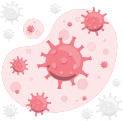Have you ever been tempted to try a snack called Ciki Kebul or Dragon's Breath? This snack is essentially a regular treat infused with a smoke effect from liquid nitrogen. While this trend has been around for some time, recent reports of health issues related to this snack have raised significant concerns.
Liquid Nitrogen in the Food Industry
Liquid nitrogen has been widely used in food processing to reduce storage time and extend product shelf life. It can also quickly freeze foods. Besides these effects, liquid nitrogen adds an eye-catching smoke effect to food and drink presentations.
While it may entertain consumers, the FDA warns that using liquid nitrogen can be very dangerous.
Risk of Adding Liquid Nitrogen to Food
The addition of liquid nitrogen to food has become increasingly popular recently, found in amusement parks, local cafes, and even snack vendors in malls. Before jumping on this trend, it's important to be aware of the risks involved:
Risk of skin burns
Liquid nitrogen has extremely low temperatures. Direct contact with liquid nitrogen can cause burns, blisters, and severe frostbite (damage to the skin and underlying tissues from extreme cold). Exposure can lead to skin damage that may require surgery or even amputation (removal of a body part, usually a limb).
For safety, protective gear such as goggles, face shields, lab coats, or aprons is necessary to shield the skin from direct contact.
Risk of throat and internal organ injuries
Liquid nitrogen can instantly freeze foods and drinks, creating a visually appealing vapor effect. However, when added to food and consumed immediately, serious injuries can occur.
If liquid nitrogen that hasn't fully evaporated enters the throat, its extremely cold temperature can cause frostbite (damage from extreme cold) or burns to the digestive tract, including the esophagus (the tube that connects the mouth to the stomach) or stomach. Digestive organs are at risk of tearing or perforation (a tear or hole in the digestive system).
Respiratory diseases
Inhaling the cold vapor from liquid nitrogen can injure the respiratory tract (the breathing passages, including the nose, throat, and lungs), particularly for individuals with respiratory conditions like asthma.
Additionally, liquid nitrogen can displace oxygen in the air; inhaling it in poorly ventilated areas can lead to oxygen deficiency (a lack of enough oxygen in the air, which can lead to serious health problems). Low oxygen levels can cause dizziness, unconsciousness, or even death.
So, are you still interested in trying food or drinks served with liquid nitrogen? Understanding these potential risks can help you stay cautious and make informed choices. Stay safe!
If you need medical advice or consultation, you can either visit a doctor or make use of the consultation features that are available in the Ai Care application by downloading the Ai Care application from the App Store or Play Store.
Looking for more tips and tricks for health, first aid, and other home remedies? Click here!
- dr. Pandu Lesmana
American Lung Association (2018). Dragon's Breath? Not Unless You Have Dragon Lungs. Available from: https://www.lung.org/blog/dragons-breath.
FDA (2018). Liquid Nitrogen and Dry Ice in the Food Code. Available from: https://www.fda.gov/media/117281/download.
Kristina Yee, Pharm.D. Liquid Nitrogen Can Cause Severe Burns. Available from: https://www.poison.org/articles/liquid-nitrogen-can-cause-severe-burns-211.
Pharmacy Times (2018). Serious Health Risks Linked to Foods Containing Liquid Nitrogen Added Immediately Before Consumption. Available from: https://www.pharmacytimes.com/view/serious-health-risks-linked-to-foods-containing-liquid-nitrogen-added-immediately-before-consumption.
Karen Appold (2018). FDA: Don’t Consume Products Prepared with Liquid Nitrogen. Available from: https://www.foodqualityandsafety.com/article/fda-dont-consume-products-prepared-with-liquid-nitrogen/.
Melissa Conrad Stoppler, MD (2021). Medical Definition of Liquid nitrogen. Available from: https://www.medicinenet.com/liquid_nitrogen/definition.htm.







